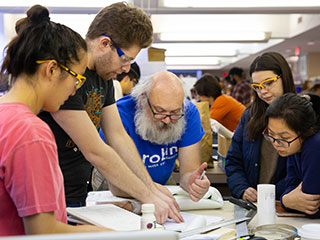Course Description
In this hands-on undergraduate class, students work in large teams of approximately 15-20 individuals to design and build working alpha prototypes of new products. The course is designed to emulate what engineers might experience as part of a design team in a modern product development firm. The large teams must work …
In this hands-on undergraduate class, students work in large teams of approximately 15-20 individuals to design and build working alpha prototypes of new products. The course is designed to emulate what engineers might experience as part of a design team in a modern product development firm. The large teams must work effectively to realize this task, so students also learn about group dynamics, team roles and management, consensus building, and the value of communication.
Each year there is a broad theme which serves as a launching point for new product opportunities. At the end of the course, teams present their work to a live audience of ~1100 practicing product designers, entrepreneurs, academics, and classmates, as well as a significant live webcast audience—in the tens of thousands.
Key Goals:
- To improve creative-thinking capability.
- To improve ability to identify significant product opportunities, and to develop appropriate solutions through a structured product development process.
- To improve expertise in constructing models for reasoning about design alternatives. These include estimations, sketches, sketch models, spreadsheets, geometric models, mockups, and prototypes.
- To improve engineering expertise and proficiency in techniques for building high-quality product models and prototypes.
- To learn about and experience structured methods for working in large teams on a project that requires teamwork to be successful.
- To improve presentation skills using a wide variety of media.
- To develop an understanding of, and enthusiasm for, the engineering activities involved with designing a new product.
- To develop an appreciation for the significance of societal contributions that can be made as a technological innovator.
Course Info
Learning Resource Types









